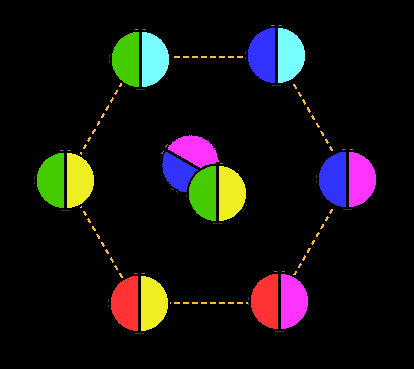
GLUONS
The gluons are the force carrying guage boson for the strong force, sometimes called the colour force. They aren't really coloured, in the way that we know colours. Colour is used to portray their characteristics because that is a good analogue. The gluons are all spin-1 particles, that is, they have integral spin and are thus bosons.
There are only eight gluons, not nine as you might expect from the available permutations of the three primary colours and their three anti-colours. The three primary colours are red, green and blue. The three anti-colours are anti-red, anti-green and anti-blue (being cyan, magenta and yellow respectively). The six shown on the periphery of the hexagon are bi-coloured gluons: green/anti-red, blue/anti-red, blue/anti-green, red/anti-green, red/anti-blue, and green/anti-blue. Note the symmetry in the diagram. The two gluons in the middle are a combination of different colours, a chimera.
This hexagonal arrangement has no significance other than to show the family relationships of the gluons to one another.

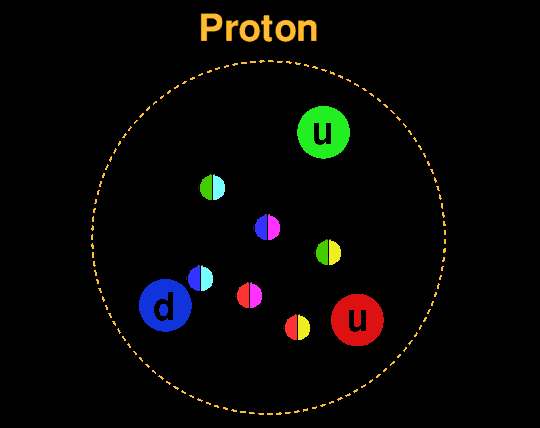
A Proton showing it's three quarks, uud, and gluon complement.
Gluons exist within baryons (combinations of three quarks) and within mesons (combinations of two quarks). The bi-coloured gluons are continually exchanging colours with the singly-coloured quarks. It is this continual swapping of colour between both themselves and with the quarks that binds the whole lot together, quarks and gluons alike. It is a colour force. The whole assembly from afar must always appear white, or colour-less.

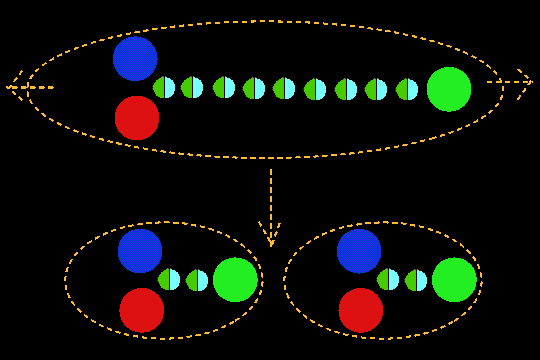
Trying to isolate a quark by pulling three apart (upper diagram) results in the birth of new quarks (lower diagram).
No colour is allowed existence alone in the Universe. A single quark cannot be isolated on its' own. If you were to try to pull a green quark apart from a red and blue quark within a baryon, the colour force between them would increase, like stretching an elastic band. The gluons would be stretched out in a line between the quarks. As the force increased, the energy done by pulling them slightly apart is sufficient to create more gluons along the same line. As the force is increased further, the gluon string may break, but the two new ends formed immediately cap themselves with new quarks. In effect by pulling on a baryon, you have supplied the energy to just created another baryon. The quarks are still not alone. It is impossible to isolate quarks. They have asymptotic freedom, the closer they are together, the free-er they are to roam. Theorists think that a collection of gluons can exist without quarks, and have named them glue-balls, but they have not yet been found in high-energy experiments. But quarks cannot exist without gluons and at least one more quark about them. Because of the force supplied by the gluons, the gluons account for a lot of the mass of the baryons and mesons.

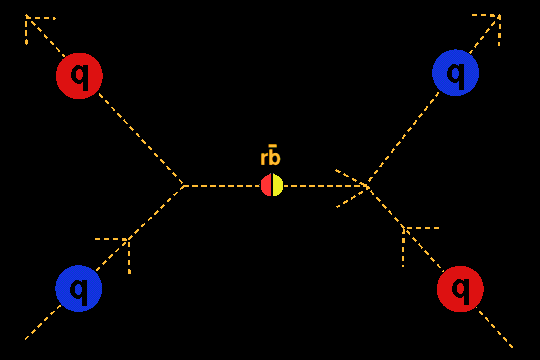
Showing interaction of two quarks and a gluon.
The above diagram shows two quarks (red and blue) coming in from the bottom. A red/anti-blue gluon is exchanged between them, reversing the colours of the original quarks. This is the nature of the colour force between quarks, which is mediated by gluons, the colour force-carrying component. The fact that quarks emit gluons, and are surrounded by a fuzz of continually created and destroyed gluons, means that you cannot isolate a quark from the gluons. Although the converse does not follow.

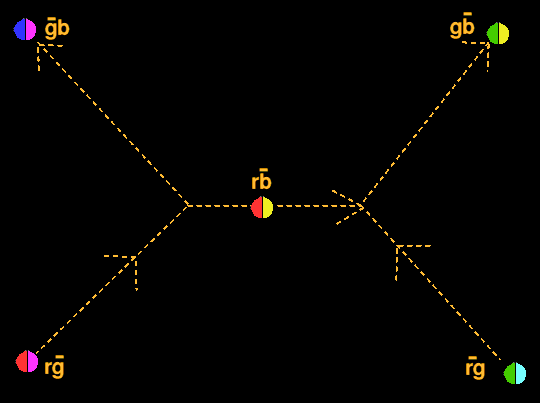
Showing interaction of two gluons.
The above diagram shows two gluons, a red/anti-green gluon and a green/anti-red gluon coming in from the bottom. A red/anti-blue gluon is exchanged between them, changing the two into an anti-green/blue and a green/anti-blue gluon, respectively. This is the nature of the colour force between the gluons themselves, the carriers of the colour force.






![]()

![]()

![]()
![]()